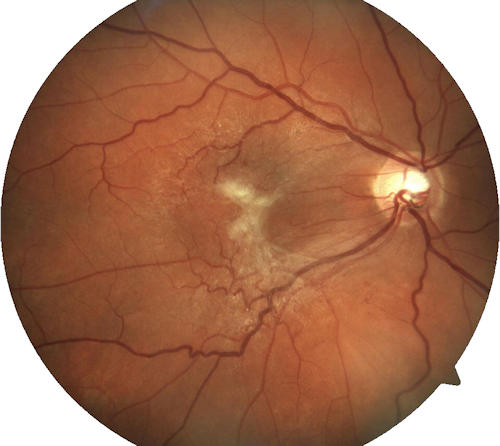
What is Epiretinal Membrane?
It is a membrane that occurs in front of the macula area of the retina, which is responsible for central vision and is sensitive to light.What are the Risk Factors for Epiretinal Membrane Development?
Epiretinal membrane can develop alone with advanced age, as well as in association with diabetes mellitus, retinal vascular diseases, post-retinal tears and detachment, retinal laser treatment, eye traumas, intraocular infections, and post-intraocular surgeries. The incidence increases with age.What are the Symptoms of Epiretinal Membrane?
In the presence of an epiretinal membrane, there may be differences in the shape and size of objects, and problems with distorted or bent vision. There may be a decrease in visual acuity to varying degrees, which can remain unchanged for many years. However, some patients may not experience any visual disturbances.How is Epiretinal Membrane Diagnosed?
Dilation of the pupil followed by dilated fundus examination can detect it. Imaging techniques such as Fundus Fluorescein Angiography (FFA) and Optical Coherence Tomography (OCT) are important in detecting epiretinal membranes and determining possible associated findings.OCT is a laser-based imaging method that scans the central vision area in thin sections and provides quick results. The presence of an epiretinal membrane is best detected with OCT. Additionally, it is highly beneficial in evaluating the presence of macular edema and macular holes.
FFA is a non-radiating angiography performed by injecting contrast material into the patient's forearm, allowing for better examination of the retinal vascular structure. It is quite useful in determining the effects of epiretinal membranes on blood vessels, the presence of vascular leakage, and, in cases of additional vascular diseases, the presence of retinal ischemia, which refers to areas of reduced blood flow in the retina and the development of new blood vessels on the retina and optic nerve.
How is Epiretinal Membrane Treated?
If the epiretinal membrane has not caused a decrease in vision, it is monitored at regular intervals.If the epiretinal membrane has caused a significant decrease in vision or is causing visual symptoms, surgical treatment is required.
Surgery involves peeling off and removing the membrane, and relieving any tension. After surgery, gas is injected into the eye, and the patient is required to maintain a face-down position for a certain period. Traveling to high altitudes and flying are prohibited until the gas is completely removed from the eye. With timely and appropriate intervention, visual improvement can be achieved.




